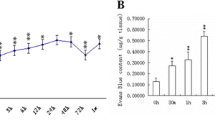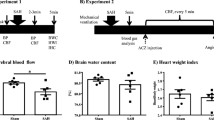Summary
The time course of the blood-arterial wall barrier disruption following experimental subarachnoid haemorrhage (SAH) was studied in 24 rabbits. Animals with SAH received two successive blood injections through the cisterna magna. Horseradish peroxidase (HRP) was given intravenously 30 minutes before sacrifice to assess the integrity of the barrier. In the basilar arteries taken from animals that were sacrificed 4 days after the first SAH, HRP-reaction products were diffusely observed in the subendothelial space. Three weeks following the first SAH, permeation of HRP was still observed in half of the animals. However, in animals sacrificed 7 weeks after the first SAH, no permeation of HRP into the subendothelial space was noted. Opening of the interendothelial space seemed to be the major mechanism for HRP permeation into the subendothelial space rather than transendothelial vesicular transport. Disruption of the bloodarterial wall barrier in the major cerebral arteries following SAH may play a role in the pathogenesis of vasospasm.
Similar content being viewed by others
References
Alksne JF, Branson PJ (1976) A comparison of intimal proliferation in experimental subarachnoid hemorrhage and atherosclerosis. Angiology 12: 712–720
Cancilla PA, Frommes SP, Kahn LE, DeBault LE (1979) Regeneration of cerebral microvessels. A morphologic and histochemical study after local freeze-injury. Lab Invest 40: 74–82
Clower BR, Haining JL, Smith RR (1980) Pathological changes in the cerebral artery after subarachnoid hemorrhage. In: Wilkins RH (ed) Cerebral arterial spasm. Williams and Wilkins, Baltimore, pp 124–131
Clowes AW, Reidy MA, Clowes M (1983) Kinetics of cellular proliferation after arterial injury: I. Smooth muscle growth in the absence of endothelium. Lab Invest 49: 327–333
Conway LW, McDonald LW (1972) Structural changes of the intradural arteries following subarachnoid hemorrhage. J Neurosurg 37: 715–723
Crompton MR (1964) The pathogenesis of cerebral infarction following the rupture of cerebral berry aneurysms. Brain 87: 491–510
Dóczi T, Ambrose J, O'Laoire S (1984) Significance of contrast enhancement in cranial computerized tomography after subarachnoid hemorrhage. J Neurosurg 60: 335–342
Fox JL, Ko JP (1978) Cerebral vasospasm: a clinical observation. Surg Neurol 10: 269–275
Graham RC, Karnovsky MJ (1966) The early stages of absorption of injected horseradish peroxidase in the proximal tubules of mouse kidney. Ultracytochemistry by a new technique. J Histochem Cytochem 14: 291–302
Hardebo JE (1980) A time study in rat on the opening and reclosure of the blood-brain barrier after hypertensive or hypertonic insult. Exp Neurol 70: 155–166
Hirata Y, Matsukado Y, Fukamura A (1982) Subarachnoid enhancement secondary to subarachnoid hemorrhage with special reference to the clinical significance and pathogenesis. Neurosurgery 11: 367–371
Hughes JT, Schianchi PM (1978) Cerebral artery spasm. A histological study at necropsy of the blood vessels in case of subarachnoid hemorrhage. J Neurosurg 48: 515–525
Inoue Y, Saiwai S, Miyamoto T, Ban S, Yamamoto T, Takemoto K, Taniguchi S, Sato S, Namba K, Ogata M (1981) Postcontrast computed tomography in subarachnoid hemorrhage from ruptured aneurysms. J Comput Assist Tomogr 5: 341–344
Johansson BB, Linder L-E (1978) Reversity of the blood-brain barrier dysfunction induced by acute hypertension. Acta Neurol Scand 57: 345–348
Liszczak TM, Black PM, Tzouras A, Foley L, Zervas NT (1984) Morphological changes of the basilar artery, ventricles, and choroid plexus after experimental SAH. J Neurosurg 61: 486–493
Mizukami M, Kim H, Araki G, Mihara H, Yoshida Y (1976) Is angiographic spasm real spasm? Acta Neurochir (Wien) 34: 247–259
Nagy Z, Pappius HA, Mathiesson G, Huttner I (1979) Opening of tight junctions in cerebral endothelium. 1. Effect of hyperosmolar mannitol infused through the internal carotid artery. Comp Neurol 185: 569–578
Persson L, Hansson H-A (1976) Reversible blood-brain barrier dysfunction to peroxidase after a small stab wound in the rat cerebral cortex. Acta Neuropath (Berl) 35: 333–342
Reidy MA, Silver M (1985) Endothelial regeneration. VII. Lack of intimai proliferation after defined injury to rat aorta. Am J Pathol 118: 173–177
Sasaki T, Kassell NF, Yamashita M, Fujiwara S, Zuccarello M (1985) Barrier disruption in the major cerebral arteries following experimental subarachnoid hemorrhage. J Neurosurg 63: 433–440
Sasaki T, Kassell NF, Zuccarello M, Nakagomi T, Fujiwara S, Colohan ART, Lehman RM (1986) Barrier disruption in the major cerebral during the acute stage after experimental subarachnoid hemorrhage. Neurosurgery 19: 177–184
Spaet TH, Stemerman MB, Veith FJ, Lejnieks I (1975) Intimai injury and regrowth in the rabbit aorta: Medial smooth muscle cells as a source of neo-intima. Circ Res 36: 58–70
Tanabe Y, Sakata K, Yamada H, Ito T, Takada M (1978) Cerebral vasospasm and ultrastructural changes in cerebral arterial wall. An experimental study. J Neurosurg 49: 229–238
Tazawa T, Mizukami M, Kawase T, Usami T, Togashi O, Hyodo A, Eguchi T (1983) Relationship between contrast enhancement on computed tomography and cerebral vasospasm in patients with subarachnoid hemorrhage. Neurosurgery 12: 643–648
Walker LN, Ramsay MM, Bowyer DE (1980) Endothelial healing following defined injury to rabbit aorta. Depth of injury and mode of repair. Atherosclerosis 47: 123–130
Author information
Authors and Affiliations
Rights and permissions
About this article
Cite this article
Nakagomi, T., Kassell, N.F., Sasaki, T. et al. Time course of the blood-arterial wall barrier disruption following experimental subarachnoid haemorrhage. Acta neurochir 98, 176–183 (1989). https://doi.org/10.1007/BF01407345
Issue Date:
DOI: https://doi.org/10.1007/BF01407345




